Case Study: Advanced Nursing Practices in a 25-Year-Old Female Patient
VerifiedAdded on 2022/10/03
|13
|4757
|447
Case Study
AI Summary
This case study presents a 25-year-old female patient who presented to the emergency department with severe abdominal pain. The assignment begins with an assessment of the patient's subjective and objective symptoms, including vital signs, medical history, and laboratory results. The pathophysiology of abdominal pain is discussed. The case study then delves into differential diagnoses, including ectopic pregnancy, acute appendicitis, and nephrolithiasis, providing reasons for each diagnosis. Investigations, including blood tests and imaging, are detailed for each potential condition. A management plan is developed, addressing the patient's non-pharmacological, pharmacological, educational, and follow-up needs, based on the SOAP (Subjective, Objective, Assessment, Plan) framework. The assignment highlights the importance of systematic assessment, accurate diagnosis, and comprehensive patient care in advanced nursing practice.
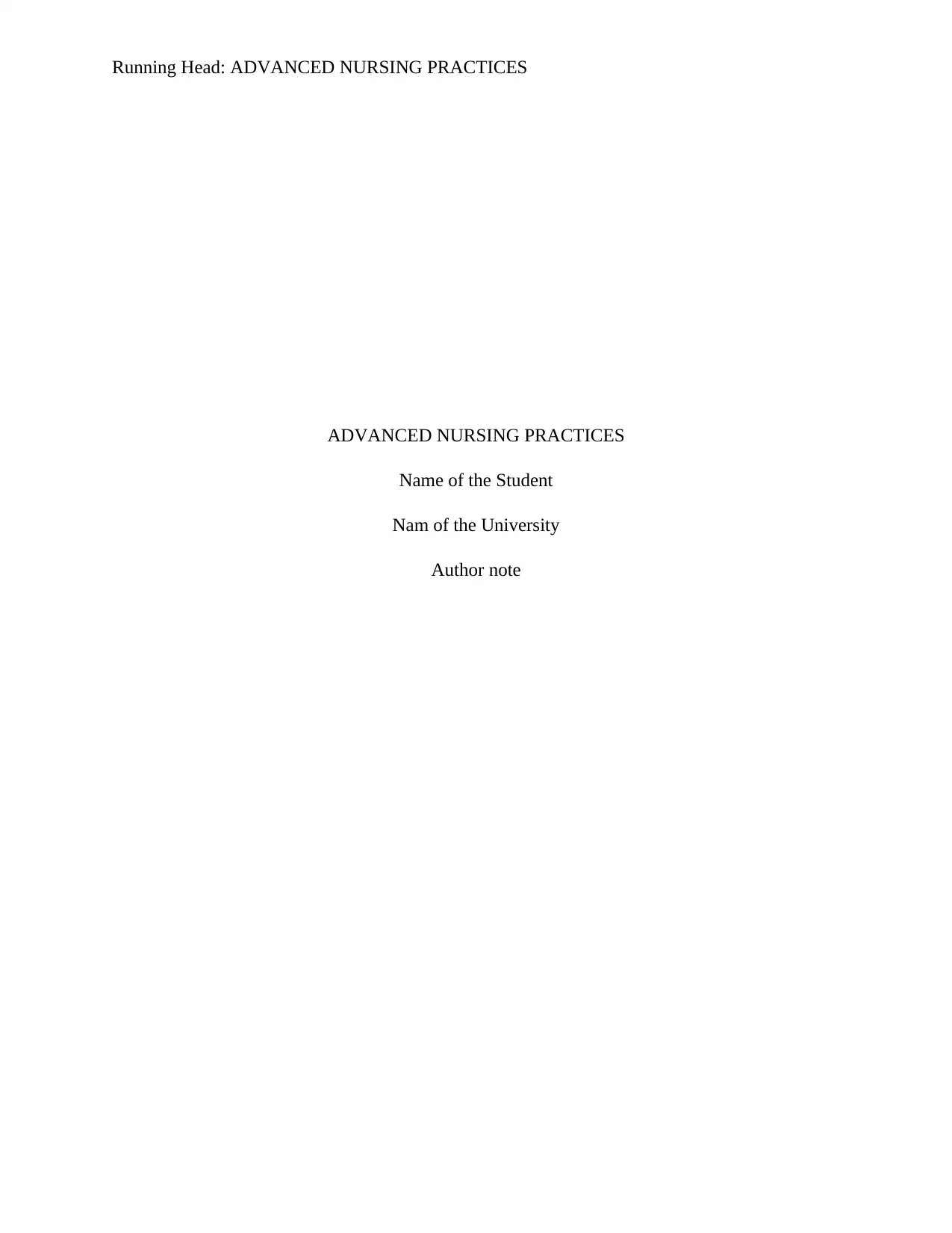
Running Head: ADVANCED NURSING PRACTICES
ADVANCED NURSING PRACTICES
Name of the Student
Nam of the University
Author note
ADVANCED NURSING PRACTICES
Name of the Student
Nam of the University
Author note
Paraphrase This Document
Need a fresh take? Get an instant paraphrase of this document with our AI Paraphraser
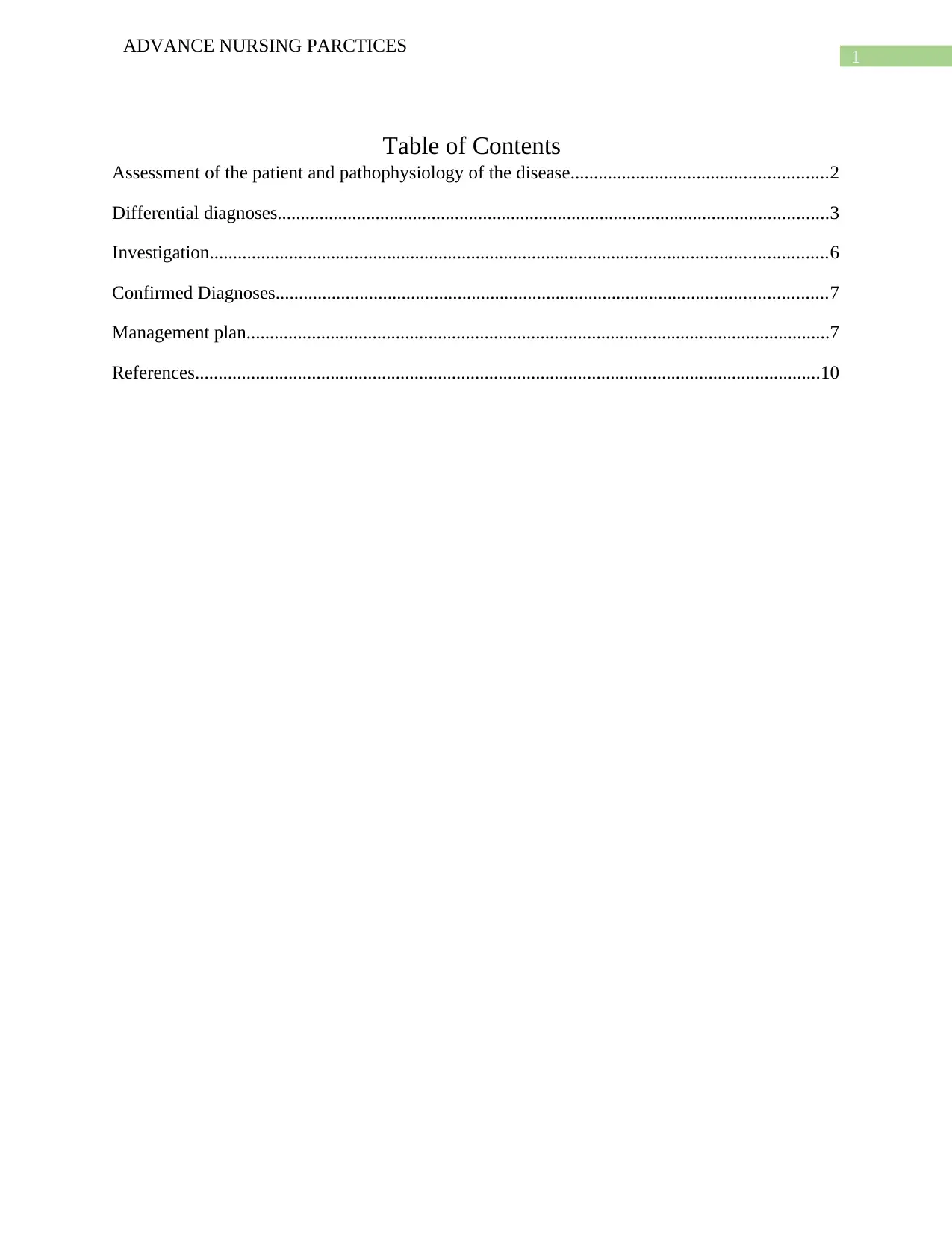
1
ADVANCE NURSING PARCTICES
Table of Contents
Assessment of the patient and pathophysiology of the disease.......................................................2
Differential diagnoses......................................................................................................................3
Investigation....................................................................................................................................6
Confirmed Diagnoses......................................................................................................................7
Management plan.............................................................................................................................7
References......................................................................................................................................10
ADVANCE NURSING PARCTICES
Table of Contents
Assessment of the patient and pathophysiology of the disease.......................................................2
Differential diagnoses......................................................................................................................3
Investigation....................................................................................................................................6
Confirmed Diagnoses......................................................................................................................7
Management plan.............................................................................................................................7
References......................................................................................................................................10
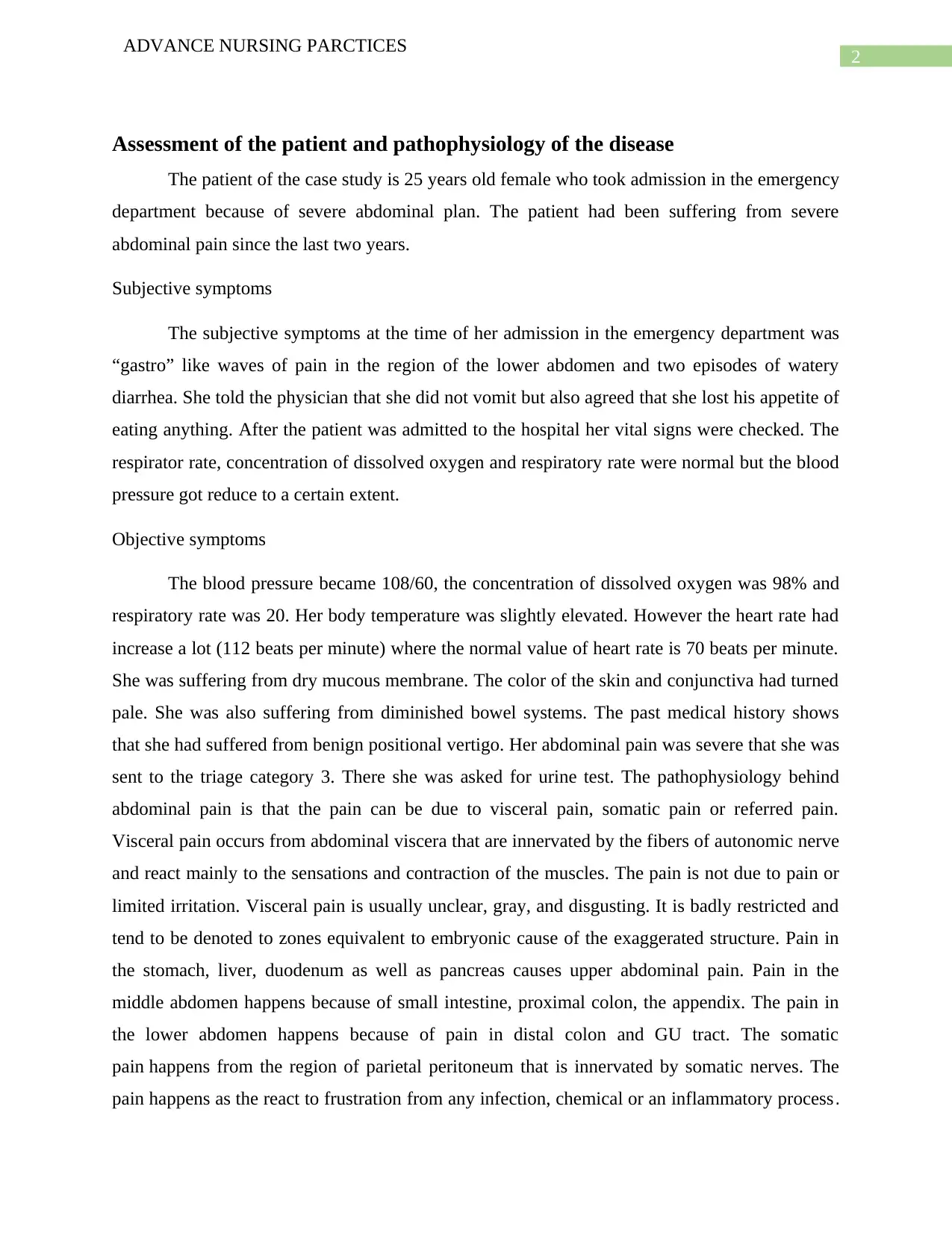
2
ADVANCE NURSING PARCTICES
Assessment of the patient and pathophysiology of the disease
The patient of the case study is 25 years old female who took admission in the emergency
department because of severe abdominal plan. The patient had been suffering from severe
abdominal pain since the last two years.
Subjective symptoms
The subjective symptoms at the time of her admission in the emergency department was
“gastro” like waves of pain in the region of the lower abdomen and two episodes of watery
diarrhea. She told the physician that she did not vomit but also agreed that she lost his appetite of
eating anything. After the patient was admitted to the hospital her vital signs were checked. The
respirator rate, concentration of dissolved oxygen and respiratory rate were normal but the blood
pressure got reduce to a certain extent.
Objective symptoms
The blood pressure became 108/60, the concentration of dissolved oxygen was 98% and
respiratory rate was 20. Her body temperature was slightly elevated. However the heart rate had
increase a lot (112 beats per minute) where the normal value of heart rate is 70 beats per minute.
She was suffering from dry mucous membrane. The color of the skin and conjunctiva had turned
pale. She was also suffering from diminished bowel systems. The past medical history shows
that she had suffered from benign positional vertigo. Her abdominal pain was severe that she was
sent to the triage category 3. There she was asked for urine test. The pathophysiology behind
abdominal pain is that the pain can be due to visceral pain, somatic pain or referred pain.
Visceral pain occurs from abdominal viscera that are innervated by the fibers of autonomic nerve
and react mainly to the sensations and contraction of the muscles. The pain is not due to pain or
limited irritation. Visceral pain is usually unclear, gray, and disgusting. It is badly restricted and
tend to be denoted to zones equivalent to embryonic cause of the exaggerated structure. Pain in
the stomach, liver, duodenum as well as pancreas causes upper abdominal pain. Pain in the
middle abdomen happens because of small intestine, proximal colon, the appendix. The pain in
the lower abdomen happens because of pain in distal colon and GU tract. The somatic
pain happens from the region of parietal peritoneum that is innervated by somatic nerves. The
pain happens as the react to frustration from any infection, chemical or an inflammatory process.
ADVANCE NURSING PARCTICES
Assessment of the patient and pathophysiology of the disease
The patient of the case study is 25 years old female who took admission in the emergency
department because of severe abdominal plan. The patient had been suffering from severe
abdominal pain since the last two years.
Subjective symptoms
The subjective symptoms at the time of her admission in the emergency department was
“gastro” like waves of pain in the region of the lower abdomen and two episodes of watery
diarrhea. She told the physician that she did not vomit but also agreed that she lost his appetite of
eating anything. After the patient was admitted to the hospital her vital signs were checked. The
respirator rate, concentration of dissolved oxygen and respiratory rate were normal but the blood
pressure got reduce to a certain extent.
Objective symptoms
The blood pressure became 108/60, the concentration of dissolved oxygen was 98% and
respiratory rate was 20. Her body temperature was slightly elevated. However the heart rate had
increase a lot (112 beats per minute) where the normal value of heart rate is 70 beats per minute.
She was suffering from dry mucous membrane. The color of the skin and conjunctiva had turned
pale. She was also suffering from diminished bowel systems. The past medical history shows
that she had suffered from benign positional vertigo. Her abdominal pain was severe that she was
sent to the triage category 3. There she was asked for urine test. The pathophysiology behind
abdominal pain is that the pain can be due to visceral pain, somatic pain or referred pain.
Visceral pain occurs from abdominal viscera that are innervated by the fibers of autonomic nerve
and react mainly to the sensations and contraction of the muscles. The pain is not due to pain or
limited irritation. Visceral pain is usually unclear, gray, and disgusting. It is badly restricted and
tend to be denoted to zones equivalent to embryonic cause of the exaggerated structure. Pain in
the stomach, liver, duodenum as well as pancreas causes upper abdominal pain. Pain in the
middle abdomen happens because of small intestine, proximal colon, the appendix. The pain in
the lower abdomen happens because of pain in distal colon and GU tract. The somatic
pain happens from the region of parietal peritoneum that is innervated by somatic nerves. The
pain happens as the react to frustration from any infection, chemical or an inflammatory process.
⊘ This is a preview!⊘
Do you want full access?
Subscribe today to unlock all pages.

Trusted by 1+ million students worldwide
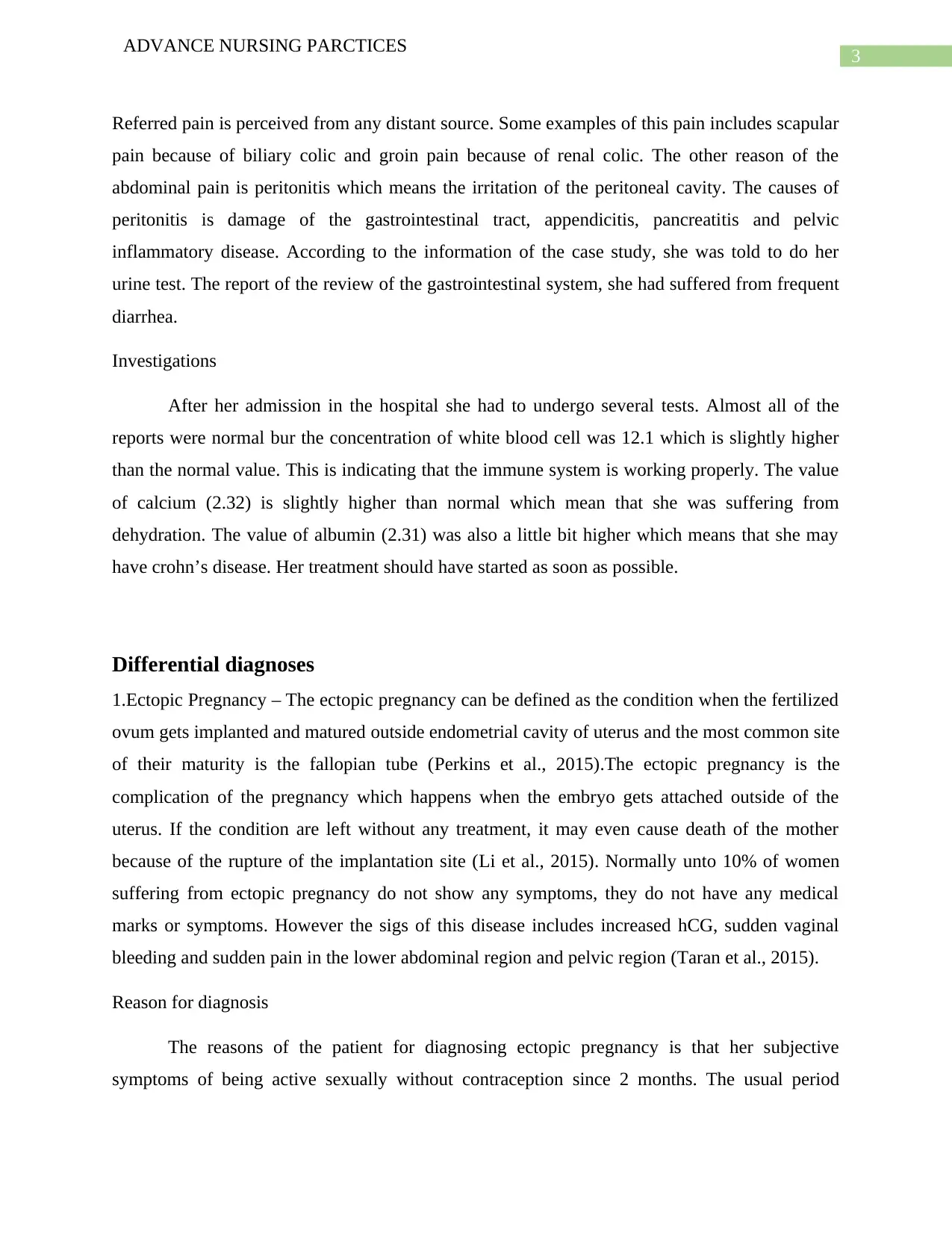
3
ADVANCE NURSING PARCTICES
Referred pain is perceived from any distant source. Some examples of this pain includes scapular
pain because of biliary colic and groin pain because of renal colic. The other reason of the
abdominal pain is peritonitis which means the irritation of the peritoneal cavity. The causes of
peritonitis is damage of the gastrointestinal tract, appendicitis, pancreatitis and pelvic
inflammatory disease. According to the information of the case study, she was told to do her
urine test. The report of the review of the gastrointestinal system, she had suffered from frequent
diarrhea.
Investigations
After her admission in the hospital she had to undergo several tests. Almost all of the
reports were normal bur the concentration of white blood cell was 12.1 which is slightly higher
than the normal value. This is indicating that the immune system is working properly. The value
of calcium (2.32) is slightly higher than normal which mean that she was suffering from
dehydration. The value of albumin (2.31) was also a little bit higher which means that she may
have crohn’s disease. Her treatment should have started as soon as possible.
Differential diagnoses
1.Ectopic Pregnancy – The ectopic pregnancy can be defined as the condition when the fertilized
ovum gets implanted and matured outside endometrial cavity of uterus and the most common site
of their maturity is the fallopian tube (Perkins et al., 2015).The ectopic pregnancy is the
complication of the pregnancy which happens when the embryo gets attached outside of the
uterus. If the condition are left without any treatment, it may even cause death of the mother
because of the rupture of the implantation site (Li et al., 2015). Normally unto 10% of women
suffering from ectopic pregnancy do not show any symptoms, they do not have any medical
marks or symptoms. However the sigs of this disease includes increased hCG, sudden vaginal
bleeding and sudden pain in the lower abdominal region and pelvic region (Taran et al., 2015).
Reason for diagnosis
The reasons of the patient for diagnosing ectopic pregnancy is that her subjective
symptoms of being active sexually without contraception since 2 months. The usual period
ADVANCE NURSING PARCTICES
Referred pain is perceived from any distant source. Some examples of this pain includes scapular
pain because of biliary colic and groin pain because of renal colic. The other reason of the
abdominal pain is peritonitis which means the irritation of the peritoneal cavity. The causes of
peritonitis is damage of the gastrointestinal tract, appendicitis, pancreatitis and pelvic
inflammatory disease. According to the information of the case study, she was told to do her
urine test. The report of the review of the gastrointestinal system, she had suffered from frequent
diarrhea.
Investigations
After her admission in the hospital she had to undergo several tests. Almost all of the
reports were normal bur the concentration of white blood cell was 12.1 which is slightly higher
than the normal value. This is indicating that the immune system is working properly. The value
of calcium (2.32) is slightly higher than normal which mean that she was suffering from
dehydration. The value of albumin (2.31) was also a little bit higher which means that she may
have crohn’s disease. Her treatment should have started as soon as possible.
Differential diagnoses
1.Ectopic Pregnancy – The ectopic pregnancy can be defined as the condition when the fertilized
ovum gets implanted and matured outside endometrial cavity of uterus and the most common site
of their maturity is the fallopian tube (Perkins et al., 2015).The ectopic pregnancy is the
complication of the pregnancy which happens when the embryo gets attached outside of the
uterus. If the condition are left without any treatment, it may even cause death of the mother
because of the rupture of the implantation site (Li et al., 2015). Normally unto 10% of women
suffering from ectopic pregnancy do not show any symptoms, they do not have any medical
marks or symptoms. However the sigs of this disease includes increased hCG, sudden vaginal
bleeding and sudden pain in the lower abdominal region and pelvic region (Taran et al., 2015).
Reason for diagnosis
The reasons of the patient for diagnosing ectopic pregnancy is that her subjective
symptoms of being active sexually without contraception since 2 months. The usual period
Paraphrase This Document
Need a fresh take? Get an instant paraphrase of this document with our AI Paraphraser
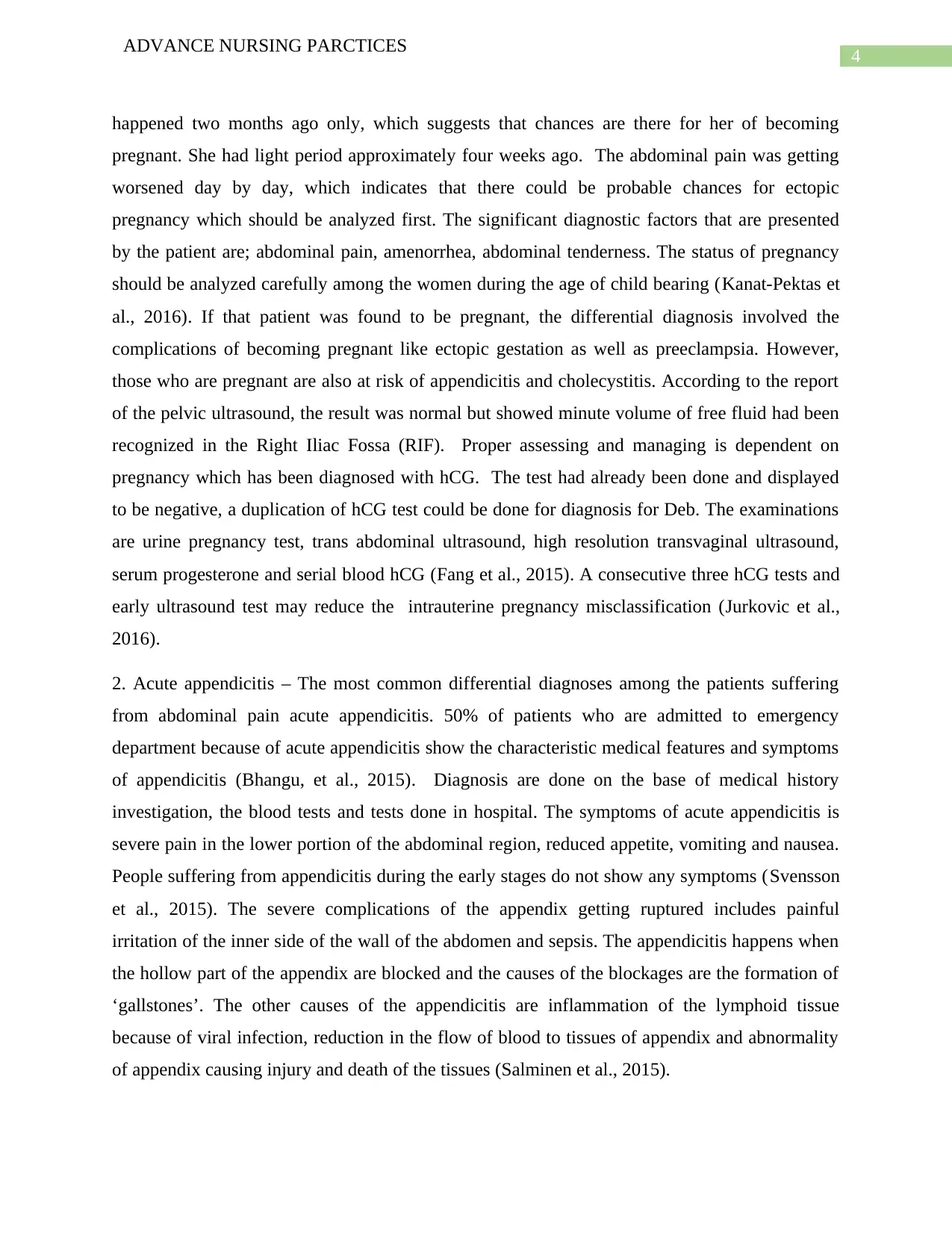
4
ADVANCE NURSING PARCTICES
happened two months ago only, which suggests that chances are there for her of becoming
pregnant. She had light period approximately four weeks ago. The abdominal pain was getting
worsened day by day, which indicates that there could be probable chances for ectopic
pregnancy which should be analyzed first. The significant diagnostic factors that are presented
by the patient are; abdominal pain, amenorrhea, abdominal tenderness. The status of pregnancy
should be analyzed carefully among the women during the age of child bearing (Kanat-Pektas et
al., 2016). If that patient was found to be pregnant, the differential diagnosis involved the
complications of becoming pregnant like ectopic gestation as well as preeclampsia. However,
those who are pregnant are also at risk of appendicitis and cholecystitis. According to the report
of the pelvic ultrasound, the result was normal but showed minute volume of free fluid had been
recognized in the Right Iliac Fossa (RIF). Proper assessing and managing is dependent on
pregnancy which has been diagnosed with hCG. The test had already been done and displayed
to be negative, a duplication of hCG test could be done for diagnosis for Deb. The examinations
are urine pregnancy test, trans abdominal ultrasound, high resolution transvaginal ultrasound,
serum progesterone and serial blood hCG (Fang et al., 2015). A consecutive three hCG tests and
early ultrasound test may reduce the intrauterine pregnancy misclassification (Jurkovic et al.,
2016).
2. Acute appendicitis – The most common differential diagnoses among the patients suffering
from abdominal pain acute appendicitis. 50% of patients who are admitted to emergency
department because of acute appendicitis show the characteristic medical features and symptoms
of appendicitis (Bhangu, et al., 2015). Diagnosis are done on the base of medical history
investigation, the blood tests and tests done in hospital. The symptoms of acute appendicitis is
severe pain in the lower portion of the abdominal region, reduced appetite, vomiting and nausea.
People suffering from appendicitis during the early stages do not show any symptoms (Svensson
et al., 2015). The severe complications of the appendix getting ruptured includes painful
irritation of the inner side of the wall of the abdomen and sepsis. The appendicitis happens when
the hollow part of the appendix are blocked and the causes of the blockages are the formation of
‘gallstones’. The other causes of the appendicitis are inflammation of the lymphoid tissue
because of viral infection, reduction in the flow of blood to tissues of appendix and abnormality
of appendix causing injury and death of the tissues (Salminen et al., 2015).
ADVANCE NURSING PARCTICES
happened two months ago only, which suggests that chances are there for her of becoming
pregnant. She had light period approximately four weeks ago. The abdominal pain was getting
worsened day by day, which indicates that there could be probable chances for ectopic
pregnancy which should be analyzed first. The significant diagnostic factors that are presented
by the patient are; abdominal pain, amenorrhea, abdominal tenderness. The status of pregnancy
should be analyzed carefully among the women during the age of child bearing (Kanat-Pektas et
al., 2016). If that patient was found to be pregnant, the differential diagnosis involved the
complications of becoming pregnant like ectopic gestation as well as preeclampsia. However,
those who are pregnant are also at risk of appendicitis and cholecystitis. According to the report
of the pelvic ultrasound, the result was normal but showed minute volume of free fluid had been
recognized in the Right Iliac Fossa (RIF). Proper assessing and managing is dependent on
pregnancy which has been diagnosed with hCG. The test had already been done and displayed
to be negative, a duplication of hCG test could be done for diagnosis for Deb. The examinations
are urine pregnancy test, trans abdominal ultrasound, high resolution transvaginal ultrasound,
serum progesterone and serial blood hCG (Fang et al., 2015). A consecutive three hCG tests and
early ultrasound test may reduce the intrauterine pregnancy misclassification (Jurkovic et al.,
2016).
2. Acute appendicitis – The most common differential diagnoses among the patients suffering
from abdominal pain acute appendicitis. 50% of patients who are admitted to emergency
department because of acute appendicitis show the characteristic medical features and symptoms
of appendicitis (Bhangu, et al., 2015). Diagnosis are done on the base of medical history
investigation, the blood tests and tests done in hospital. The symptoms of acute appendicitis is
severe pain in the lower portion of the abdominal region, reduced appetite, vomiting and nausea.
People suffering from appendicitis during the early stages do not show any symptoms (Svensson
et al., 2015). The severe complications of the appendix getting ruptured includes painful
irritation of the inner side of the wall of the abdomen and sepsis. The appendicitis happens when
the hollow part of the appendix are blocked and the causes of the blockages are the formation of
‘gallstones’. The other causes of the appendicitis are inflammation of the lymphoid tissue
because of viral infection, reduction in the flow of blood to tissues of appendix and abnormality
of appendix causing injury and death of the tissues (Salminen et al., 2015).
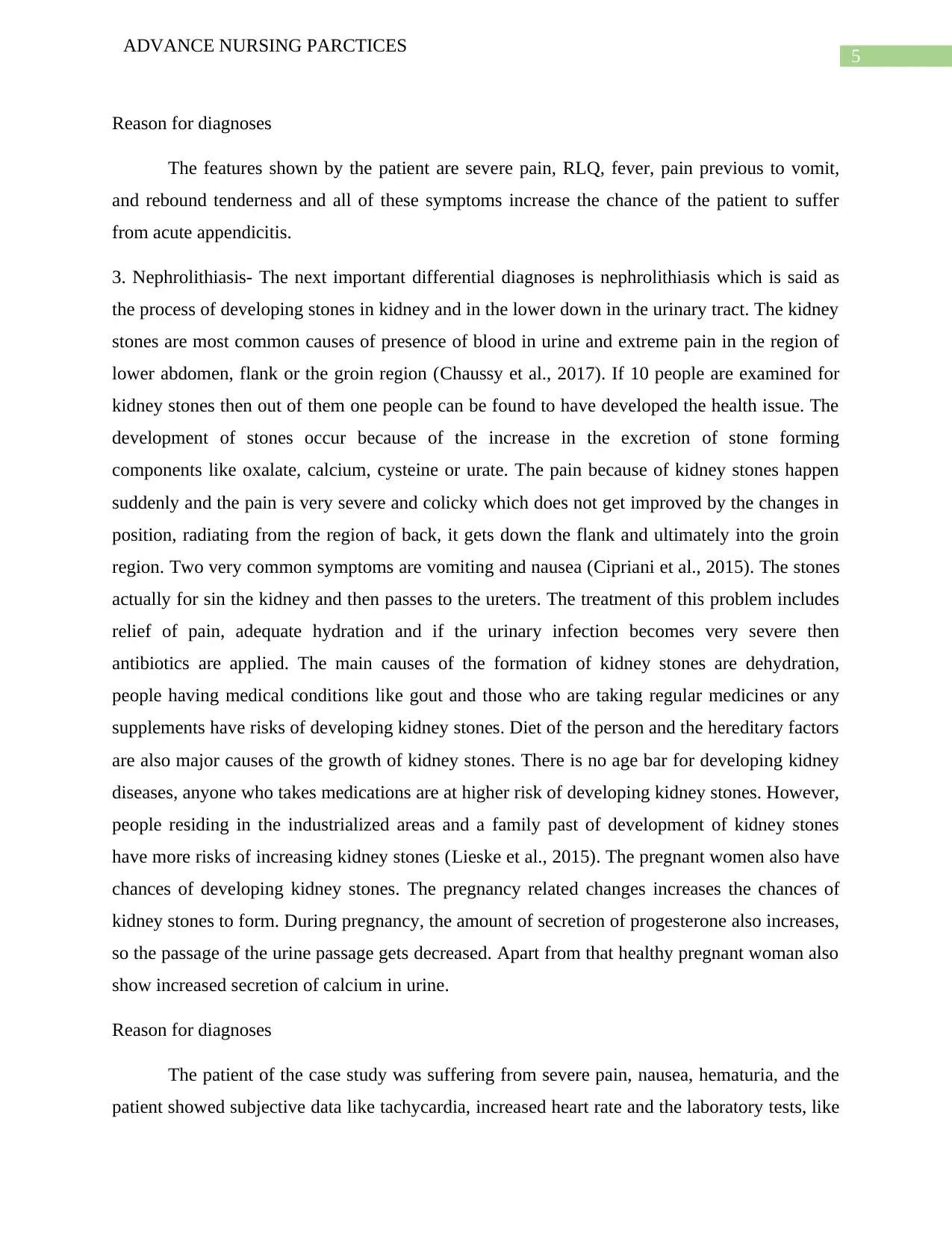
5
ADVANCE NURSING PARCTICES
Reason for diagnoses
The features shown by the patient are severe pain, RLQ, fever, pain previous to vomit,
and rebound tenderness and all of these symptoms increase the chance of the patient to suffer
from acute appendicitis.
3. Nephrolithiasis- The next important differential diagnoses is nephrolithiasis which is said as
the process of developing stones in kidney and in the lower down in the urinary tract. The kidney
stones are most common causes of presence of blood in urine and extreme pain in the region of
lower abdomen, flank or the groin region (Chaussy et al., 2017). If 10 people are examined for
kidney stones then out of them one people can be found to have developed the health issue. The
development of stones occur because of the increase in the excretion of stone forming
components like oxalate, calcium, cysteine or urate. The pain because of kidney stones happen
suddenly and the pain is very severe and colicky which does not get improved by the changes in
position, radiating from the region of back, it gets down the flank and ultimately into the groin
region. Two very common symptoms are vomiting and nausea (Cipriani et al., 2015). The stones
actually for sin the kidney and then passes to the ureters. The treatment of this problem includes
relief of pain, adequate hydration and if the urinary infection becomes very severe then
antibiotics are applied. The main causes of the formation of kidney stones are dehydration,
people having medical conditions like gout and those who are taking regular medicines or any
supplements have risks of developing kidney stones. Diet of the person and the hereditary factors
are also major causes of the growth of kidney stones. There is no age bar for developing kidney
diseases, anyone who takes medications are at higher risk of developing kidney stones. However,
people residing in the industrialized areas and a family past of development of kidney stones
have more risks of increasing kidney stones (Lieske et al., 2015). The pregnant women also have
chances of developing kidney stones. The pregnancy related changes increases the chances of
kidney stones to form. During pregnancy, the amount of secretion of progesterone also increases,
so the passage of the urine passage gets decreased. Apart from that healthy pregnant woman also
show increased secretion of calcium in urine.
Reason for diagnoses
The patient of the case study was suffering from severe pain, nausea, hematuria, and the
patient showed subjective data like tachycardia, increased heart rate and the laboratory tests, like
ADVANCE NURSING PARCTICES
Reason for diagnoses
The features shown by the patient are severe pain, RLQ, fever, pain previous to vomit,
and rebound tenderness and all of these symptoms increase the chance of the patient to suffer
from acute appendicitis.
3. Nephrolithiasis- The next important differential diagnoses is nephrolithiasis which is said as
the process of developing stones in kidney and in the lower down in the urinary tract. The kidney
stones are most common causes of presence of blood in urine and extreme pain in the region of
lower abdomen, flank or the groin region (Chaussy et al., 2017). If 10 people are examined for
kidney stones then out of them one people can be found to have developed the health issue. The
development of stones occur because of the increase in the excretion of stone forming
components like oxalate, calcium, cysteine or urate. The pain because of kidney stones happen
suddenly and the pain is very severe and colicky which does not get improved by the changes in
position, radiating from the region of back, it gets down the flank and ultimately into the groin
region. Two very common symptoms are vomiting and nausea (Cipriani et al., 2015). The stones
actually for sin the kidney and then passes to the ureters. The treatment of this problem includes
relief of pain, adequate hydration and if the urinary infection becomes very severe then
antibiotics are applied. The main causes of the formation of kidney stones are dehydration,
people having medical conditions like gout and those who are taking regular medicines or any
supplements have risks of developing kidney stones. Diet of the person and the hereditary factors
are also major causes of the growth of kidney stones. There is no age bar for developing kidney
diseases, anyone who takes medications are at higher risk of developing kidney stones. However,
people residing in the industrialized areas and a family past of development of kidney stones
have more risks of increasing kidney stones (Lieske et al., 2015). The pregnant women also have
chances of developing kidney stones. The pregnancy related changes increases the chances of
kidney stones to form. During pregnancy, the amount of secretion of progesterone also increases,
so the passage of the urine passage gets decreased. Apart from that healthy pregnant woman also
show increased secretion of calcium in urine.
Reason for diagnoses
The patient of the case study was suffering from severe pain, nausea, hematuria, and the
patient showed subjective data like tachycardia, increased heart rate and the laboratory tests, like
⊘ This is a preview!⊘
Do you want full access?
Subscribe today to unlock all pages.

Trusted by 1+ million students worldwide
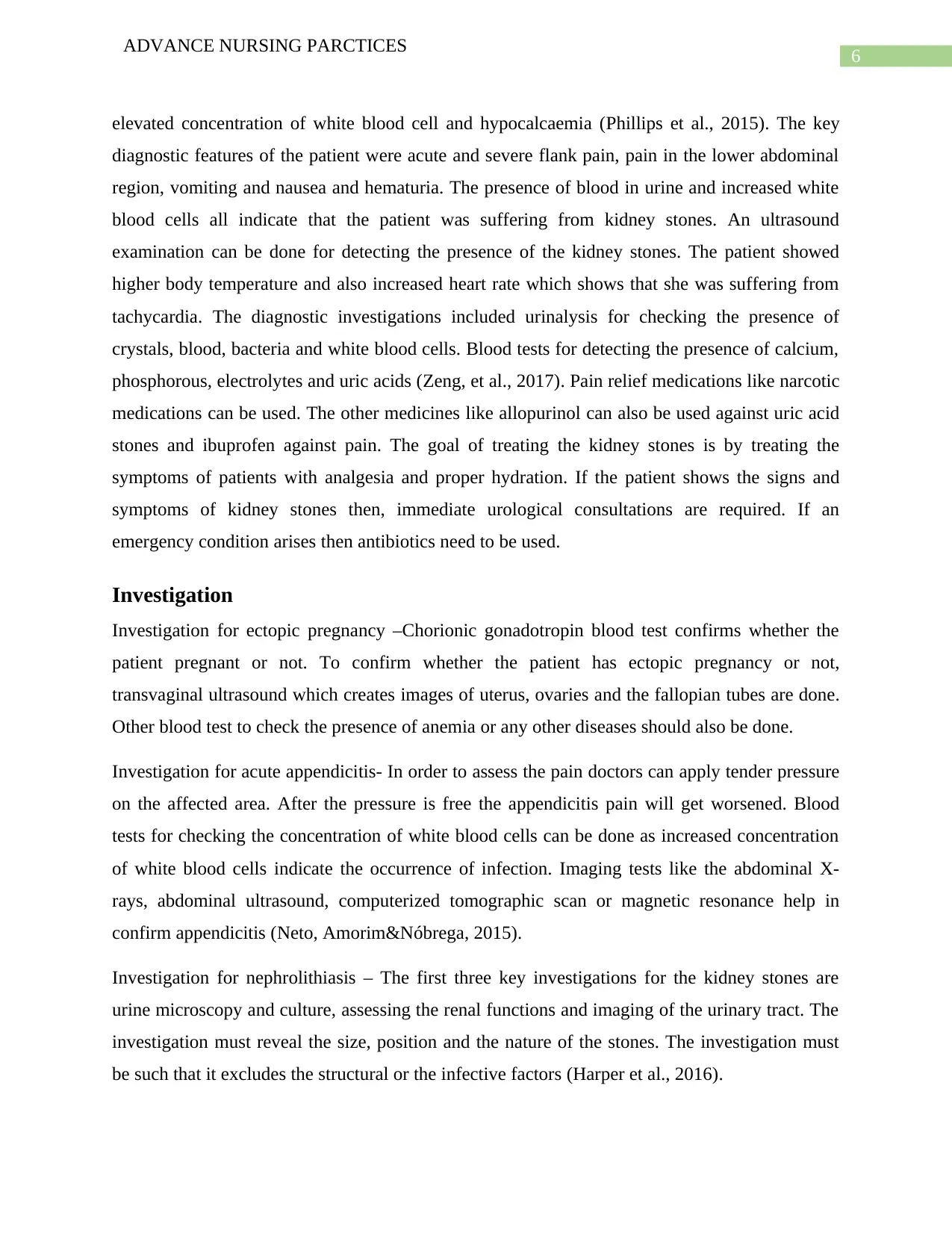
6
ADVANCE NURSING PARCTICES
elevated concentration of white blood cell and hypocalcaemia (Phillips et al., 2015). The key
diagnostic features of the patient were acute and severe flank pain, pain in the lower abdominal
region, vomiting and nausea and hematuria. The presence of blood in urine and increased white
blood cells all indicate that the patient was suffering from kidney stones. An ultrasound
examination can be done for detecting the presence of the kidney stones. The patient showed
higher body temperature and also increased heart rate which shows that she was suffering from
tachycardia. The diagnostic investigations included urinalysis for checking the presence of
crystals, blood, bacteria and white blood cells. Blood tests for detecting the presence of calcium,
phosphorous, electrolytes and uric acids (Zeng, et al., 2017). Pain relief medications like narcotic
medications can be used. The other medicines like allopurinol can also be used against uric acid
stones and ibuprofen against pain. The goal of treating the kidney stones is by treating the
symptoms of patients with analgesia and proper hydration. If the patient shows the signs and
symptoms of kidney stones then, immediate urological consultations are required. If an
emergency condition arises then antibiotics need to be used.
Investigation
Investigation for ectopic pregnancy –Chorionic gonadotropin blood test confirms whether the
patient pregnant or not. To confirm whether the patient has ectopic pregnancy or not,
transvaginal ultrasound which creates images of uterus, ovaries and the fallopian tubes are done.
Other blood test to check the presence of anemia or any other diseases should also be done.
Investigation for acute appendicitis- In order to assess the pain doctors can apply tender pressure
on the affected area. After the pressure is free the appendicitis pain will get worsened. Blood
tests for checking the concentration of white blood cells can be done as increased concentration
of white blood cells indicate the occurrence of infection. Imaging tests like the abdominal X-
rays, abdominal ultrasound, computerized tomographic scan or magnetic resonance help in
confirm appendicitis (Neto, Amorim&Nóbrega, 2015).
Investigation for nephrolithiasis – The first three key investigations for the kidney stones are
urine microscopy and culture, assessing the renal functions and imaging of the urinary tract. The
investigation must reveal the size, position and the nature of the stones. The investigation must
be such that it excludes the structural or the infective factors (Harper et al., 2016).
ADVANCE NURSING PARCTICES
elevated concentration of white blood cell and hypocalcaemia (Phillips et al., 2015). The key
diagnostic features of the patient were acute and severe flank pain, pain in the lower abdominal
region, vomiting and nausea and hematuria. The presence of blood in urine and increased white
blood cells all indicate that the patient was suffering from kidney stones. An ultrasound
examination can be done for detecting the presence of the kidney stones. The patient showed
higher body temperature and also increased heart rate which shows that she was suffering from
tachycardia. The diagnostic investigations included urinalysis for checking the presence of
crystals, blood, bacteria and white blood cells. Blood tests for detecting the presence of calcium,
phosphorous, electrolytes and uric acids (Zeng, et al., 2017). Pain relief medications like narcotic
medications can be used. The other medicines like allopurinol can also be used against uric acid
stones and ibuprofen against pain. The goal of treating the kidney stones is by treating the
symptoms of patients with analgesia and proper hydration. If the patient shows the signs and
symptoms of kidney stones then, immediate urological consultations are required. If an
emergency condition arises then antibiotics need to be used.
Investigation
Investigation for ectopic pregnancy –Chorionic gonadotropin blood test confirms whether the
patient pregnant or not. To confirm whether the patient has ectopic pregnancy or not,
transvaginal ultrasound which creates images of uterus, ovaries and the fallopian tubes are done.
Other blood test to check the presence of anemia or any other diseases should also be done.
Investigation for acute appendicitis- In order to assess the pain doctors can apply tender pressure
on the affected area. After the pressure is free the appendicitis pain will get worsened. Blood
tests for checking the concentration of white blood cells can be done as increased concentration
of white blood cells indicate the occurrence of infection. Imaging tests like the abdominal X-
rays, abdominal ultrasound, computerized tomographic scan or magnetic resonance help in
confirm appendicitis (Neto, Amorim&Nóbrega, 2015).
Investigation for nephrolithiasis – The first three key investigations for the kidney stones are
urine microscopy and culture, assessing the renal functions and imaging of the urinary tract. The
investigation must reveal the size, position and the nature of the stones. The investigation must
be such that it excludes the structural or the infective factors (Harper et al., 2016).
Paraphrase This Document
Need a fresh take? Get an instant paraphrase of this document with our AI Paraphraser
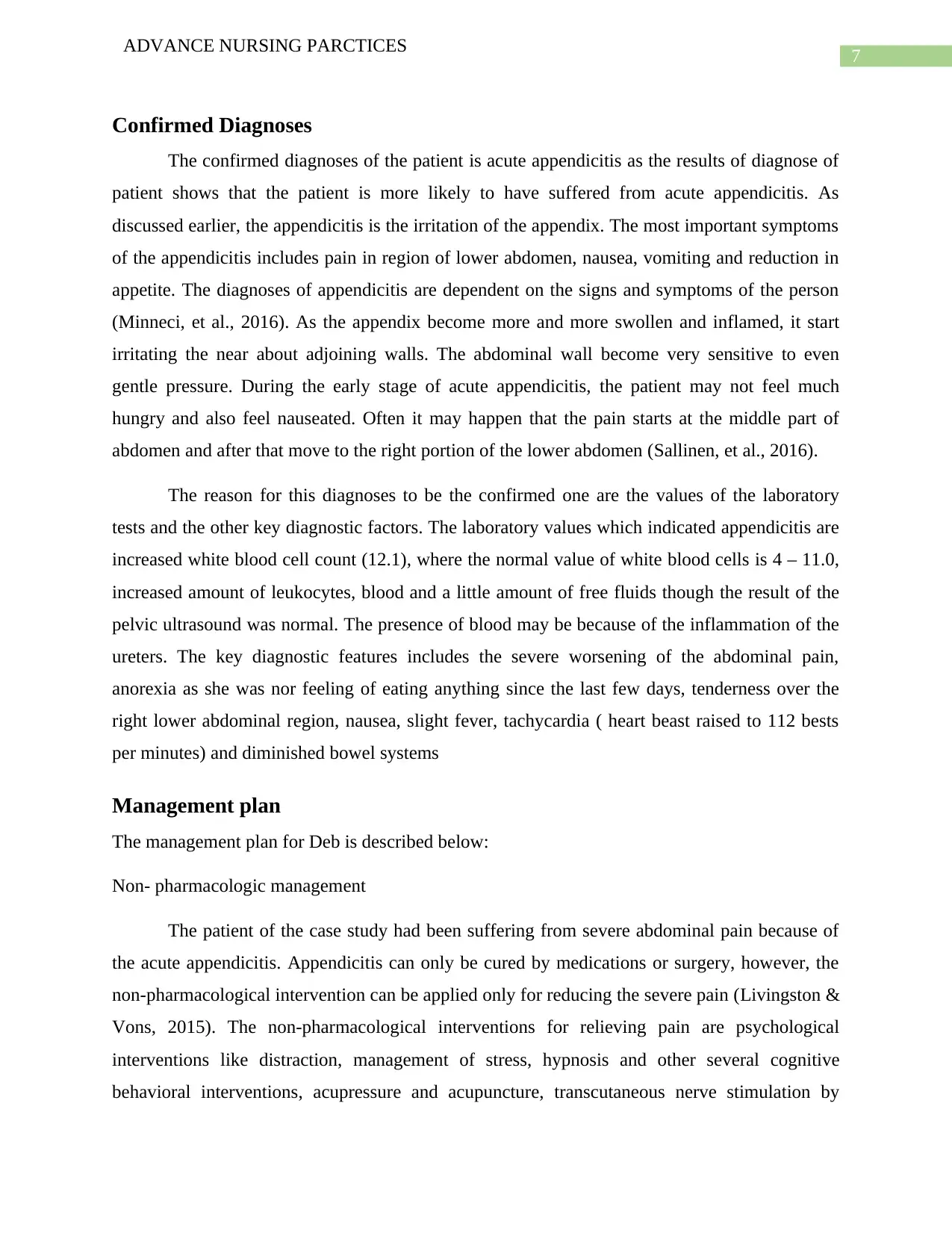
7
ADVANCE NURSING PARCTICES
Confirmed Diagnoses
The confirmed diagnoses of the patient is acute appendicitis as the results of diagnose of
patient shows that the patient is more likely to have suffered from acute appendicitis. As
discussed earlier, the appendicitis is the irritation of the appendix. The most important symptoms
of the appendicitis includes pain in region of lower abdomen, nausea, vomiting and reduction in
appetite. The diagnoses of appendicitis are dependent on the signs and symptoms of the person
(Minneci, et al., 2016). As the appendix become more and more swollen and inflamed, it start
irritating the near about adjoining walls. The abdominal wall become very sensitive to even
gentle pressure. During the early stage of acute appendicitis, the patient may not feel much
hungry and also feel nauseated. Often it may happen that the pain starts at the middle part of
abdomen and after that move to the right portion of the lower abdomen (Sallinen, et al., 2016).
The reason for this diagnoses to be the confirmed one are the values of the laboratory
tests and the other key diagnostic factors. The laboratory values which indicated appendicitis are
increased white blood cell count (12.1), where the normal value of white blood cells is 4 – 11.0,
increased amount of leukocytes, blood and a little amount of free fluids though the result of the
pelvic ultrasound was normal. The presence of blood may be because of the inflammation of the
ureters. The key diagnostic features includes the severe worsening of the abdominal pain,
anorexia as she was nor feeling of eating anything since the last few days, tenderness over the
right lower abdominal region, nausea, slight fever, tachycardia ( heart beast raised to 112 bests
per minutes) and diminished bowel systems
Management plan
The management plan for Deb is described below:
Non- pharmacologic management
The patient of the case study had been suffering from severe abdominal pain because of
the acute appendicitis. Appendicitis can only be cured by medications or surgery, however, the
non-pharmacological intervention can be applied only for reducing the severe pain (Livingston &
Vons, 2015). The non-pharmacological interventions for relieving pain are psychological
interventions like distraction, management of stress, hypnosis and other several cognitive
behavioral interventions, acupressure and acupuncture, transcutaneous nerve stimulation by
ADVANCE NURSING PARCTICES
Confirmed Diagnoses
The confirmed diagnoses of the patient is acute appendicitis as the results of diagnose of
patient shows that the patient is more likely to have suffered from acute appendicitis. As
discussed earlier, the appendicitis is the irritation of the appendix. The most important symptoms
of the appendicitis includes pain in region of lower abdomen, nausea, vomiting and reduction in
appetite. The diagnoses of appendicitis are dependent on the signs and symptoms of the person
(Minneci, et al., 2016). As the appendix become more and more swollen and inflamed, it start
irritating the near about adjoining walls. The abdominal wall become very sensitive to even
gentle pressure. During the early stage of acute appendicitis, the patient may not feel much
hungry and also feel nauseated. Often it may happen that the pain starts at the middle part of
abdomen and after that move to the right portion of the lower abdomen (Sallinen, et al., 2016).
The reason for this diagnoses to be the confirmed one are the values of the laboratory
tests and the other key diagnostic factors. The laboratory values which indicated appendicitis are
increased white blood cell count (12.1), where the normal value of white blood cells is 4 – 11.0,
increased amount of leukocytes, blood and a little amount of free fluids though the result of the
pelvic ultrasound was normal. The presence of blood may be because of the inflammation of the
ureters. The key diagnostic features includes the severe worsening of the abdominal pain,
anorexia as she was nor feeling of eating anything since the last few days, tenderness over the
right lower abdominal region, nausea, slight fever, tachycardia ( heart beast raised to 112 bests
per minutes) and diminished bowel systems
Management plan
The management plan for Deb is described below:
Non- pharmacologic management
The patient of the case study had been suffering from severe abdominal pain because of
the acute appendicitis. Appendicitis can only be cured by medications or surgery, however, the
non-pharmacological intervention can be applied only for reducing the severe pain (Livingston &
Vons, 2015). The non-pharmacological interventions for relieving pain are psychological
interventions like distraction, management of stress, hypnosis and other several cognitive
behavioral interventions, acupressure and acupuncture, transcutaneous nerve stimulation by
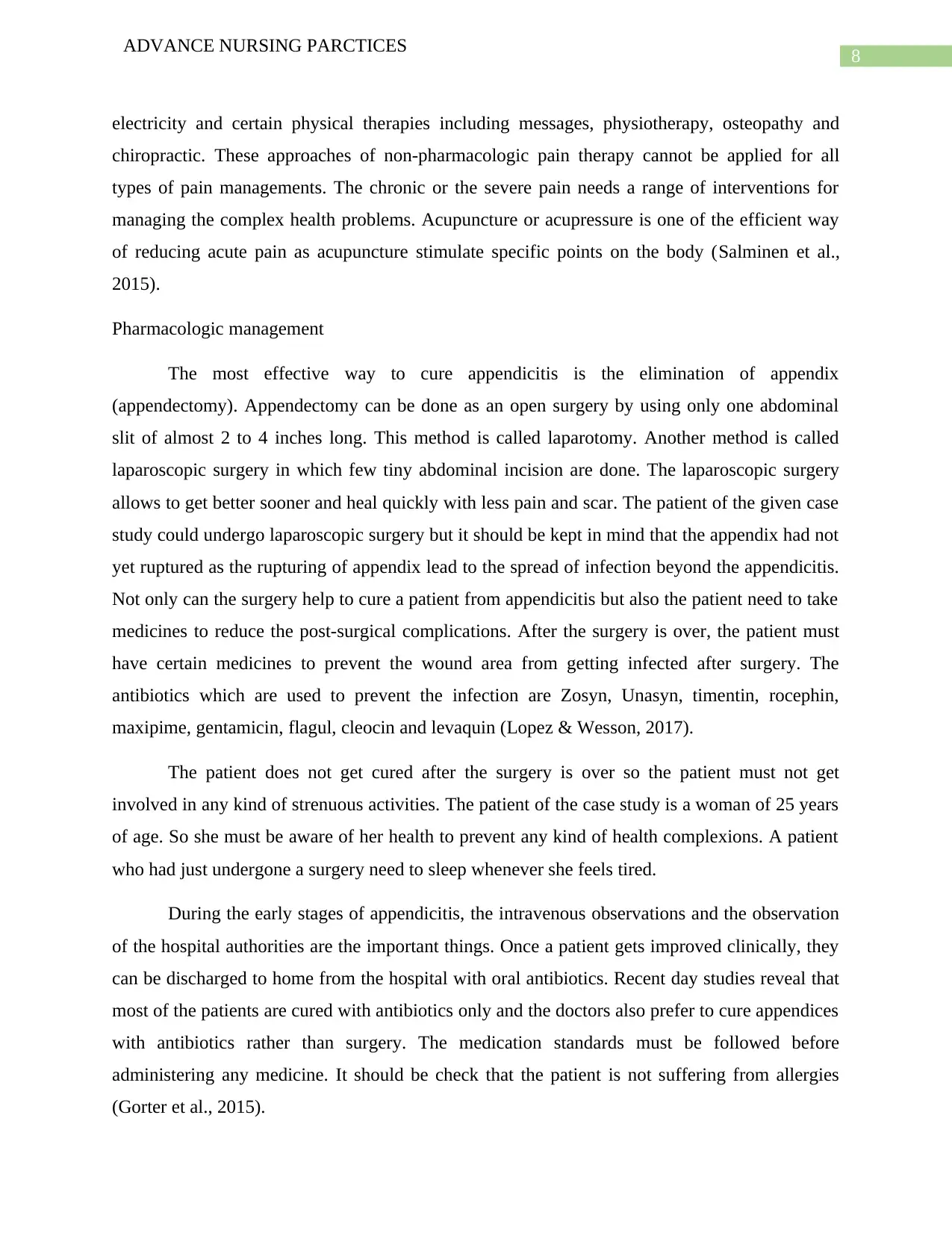
8
ADVANCE NURSING PARCTICES
electricity and certain physical therapies including messages, physiotherapy, osteopathy and
chiropractic. These approaches of non-pharmacologic pain therapy cannot be applied for all
types of pain managements. The chronic or the severe pain needs a range of interventions for
managing the complex health problems. Acupuncture or acupressure is one of the efficient way
of reducing acute pain as acupuncture stimulate specific points on the body (Salminen et al.,
2015).
Pharmacologic management
The most effective way to cure appendicitis is the elimination of appendix
(appendectomy). Appendectomy can be done as an open surgery by using only one abdominal
slit of almost 2 to 4 inches long. This method is called laparotomy. Another method is called
laparoscopic surgery in which few tiny abdominal incision are done. The laparoscopic surgery
allows to get better sooner and heal quickly with less pain and scar. The patient of the given case
study could undergo laparoscopic surgery but it should be kept in mind that the appendix had not
yet ruptured as the rupturing of appendix lead to the spread of infection beyond the appendicitis.
Not only can the surgery help to cure a patient from appendicitis but also the patient need to take
medicines to reduce the post-surgical complications. After the surgery is over, the patient must
have certain medicines to prevent the wound area from getting infected after surgery. The
antibiotics which are used to prevent the infection are Zosyn, Unasyn, timentin, rocephin,
maxipime, gentamicin, flagul, cleocin and levaquin (Lopez & Wesson, 2017).
The patient does not get cured after the surgery is over so the patient must not get
involved in any kind of strenuous activities. The patient of the case study is a woman of 25 years
of age. So she must be aware of her health to prevent any kind of health complexions. A patient
who had just undergone a surgery need to sleep whenever she feels tired.
During the early stages of appendicitis, the intravenous observations and the observation
of the hospital authorities are the important things. Once a patient gets improved clinically, they
can be discharged to home from the hospital with oral antibiotics. Recent day studies reveal that
most of the patients are cured with antibiotics only and the doctors also prefer to cure appendices
with antibiotics rather than surgery. The medication standards must be followed before
administering any medicine. It should be check that the patient is not suffering from allergies
(Gorter et al., 2015).
ADVANCE NURSING PARCTICES
electricity and certain physical therapies including messages, physiotherapy, osteopathy and
chiropractic. These approaches of non-pharmacologic pain therapy cannot be applied for all
types of pain managements. The chronic or the severe pain needs a range of interventions for
managing the complex health problems. Acupuncture or acupressure is one of the efficient way
of reducing acute pain as acupuncture stimulate specific points on the body (Salminen et al.,
2015).
Pharmacologic management
The most effective way to cure appendicitis is the elimination of appendix
(appendectomy). Appendectomy can be done as an open surgery by using only one abdominal
slit of almost 2 to 4 inches long. This method is called laparotomy. Another method is called
laparoscopic surgery in which few tiny abdominal incision are done. The laparoscopic surgery
allows to get better sooner and heal quickly with less pain and scar. The patient of the given case
study could undergo laparoscopic surgery but it should be kept in mind that the appendix had not
yet ruptured as the rupturing of appendix lead to the spread of infection beyond the appendicitis.
Not only can the surgery help to cure a patient from appendicitis but also the patient need to take
medicines to reduce the post-surgical complications. After the surgery is over, the patient must
have certain medicines to prevent the wound area from getting infected after surgery. The
antibiotics which are used to prevent the infection are Zosyn, Unasyn, timentin, rocephin,
maxipime, gentamicin, flagul, cleocin and levaquin (Lopez & Wesson, 2017).
The patient does not get cured after the surgery is over so the patient must not get
involved in any kind of strenuous activities. The patient of the case study is a woman of 25 years
of age. So she must be aware of her health to prevent any kind of health complexions. A patient
who had just undergone a surgery need to sleep whenever she feels tired.
During the early stages of appendicitis, the intravenous observations and the observation
of the hospital authorities are the important things. Once a patient gets improved clinically, they
can be discharged to home from the hospital with oral antibiotics. Recent day studies reveal that
most of the patients are cured with antibiotics only and the doctors also prefer to cure appendices
with antibiotics rather than surgery. The medication standards must be followed before
administering any medicine. It should be check that the patient is not suffering from allergies
(Gorter et al., 2015).
⊘ This is a preview!⊘
Do you want full access?
Subscribe today to unlock all pages.

Trusted by 1+ million students worldwide
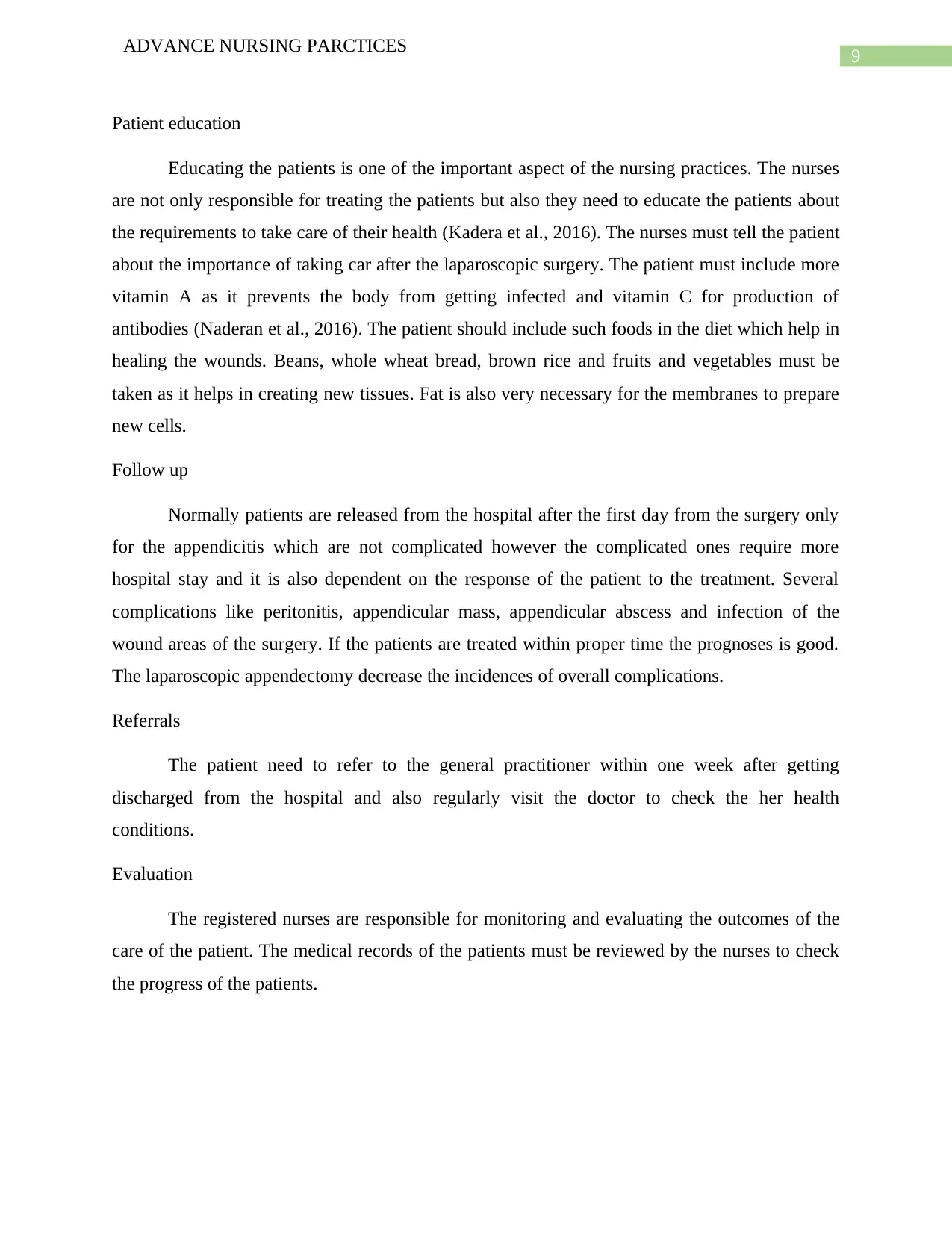
9
ADVANCE NURSING PARCTICES
Patient education
Educating the patients is one of the important aspect of the nursing practices. The nurses
are not only responsible for treating the patients but also they need to educate the patients about
the requirements to take care of their health (Kadera et al., 2016). The nurses must tell the patient
about the importance of taking car after the laparoscopic surgery. The patient must include more
vitamin A as it prevents the body from getting infected and vitamin C for production of
antibodies (Naderan et al., 2016). The patient should include such foods in the diet which help in
healing the wounds. Beans, whole wheat bread, brown rice and fruits and vegetables must be
taken as it helps in creating new tissues. Fat is also very necessary for the membranes to prepare
new cells.
Follow up
Normally patients are released from the hospital after the first day from the surgery only
for the appendicitis which are not complicated however the complicated ones require more
hospital stay and it is also dependent on the response of the patient to the treatment. Several
complications like peritonitis, appendicular mass, appendicular abscess and infection of the
wound areas of the surgery. If the patients are treated within proper time the prognoses is good.
The laparoscopic appendectomy decrease the incidences of overall complications.
Referrals
The patient need to refer to the general practitioner within one week after getting
discharged from the hospital and also regularly visit the doctor to check the her health
conditions.
Evaluation
The registered nurses are responsible for monitoring and evaluating the outcomes of the
care of the patient. The medical records of the patients must be reviewed by the nurses to check
the progress of the patients.
ADVANCE NURSING PARCTICES
Patient education
Educating the patients is one of the important aspect of the nursing practices. The nurses
are not only responsible for treating the patients but also they need to educate the patients about
the requirements to take care of their health (Kadera et al., 2016). The nurses must tell the patient
about the importance of taking car after the laparoscopic surgery. The patient must include more
vitamin A as it prevents the body from getting infected and vitamin C for production of
antibodies (Naderan et al., 2016). The patient should include such foods in the diet which help in
healing the wounds. Beans, whole wheat bread, brown rice and fruits and vegetables must be
taken as it helps in creating new tissues. Fat is also very necessary for the membranes to prepare
new cells.
Follow up
Normally patients are released from the hospital after the first day from the surgery only
for the appendicitis which are not complicated however the complicated ones require more
hospital stay and it is also dependent on the response of the patient to the treatment. Several
complications like peritonitis, appendicular mass, appendicular abscess and infection of the
wound areas of the surgery. If the patients are treated within proper time the prognoses is good.
The laparoscopic appendectomy decrease the incidences of overall complications.
Referrals
The patient need to refer to the general practitioner within one week after getting
discharged from the hospital and also regularly visit the doctor to check the her health
conditions.
Evaluation
The registered nurses are responsible for monitoring and evaluating the outcomes of the
care of the patient. The medical records of the patients must be reviewed by the nurses to check
the progress of the patients.
Paraphrase This Document
Need a fresh take? Get an instant paraphrase of this document with our AI Paraphraser
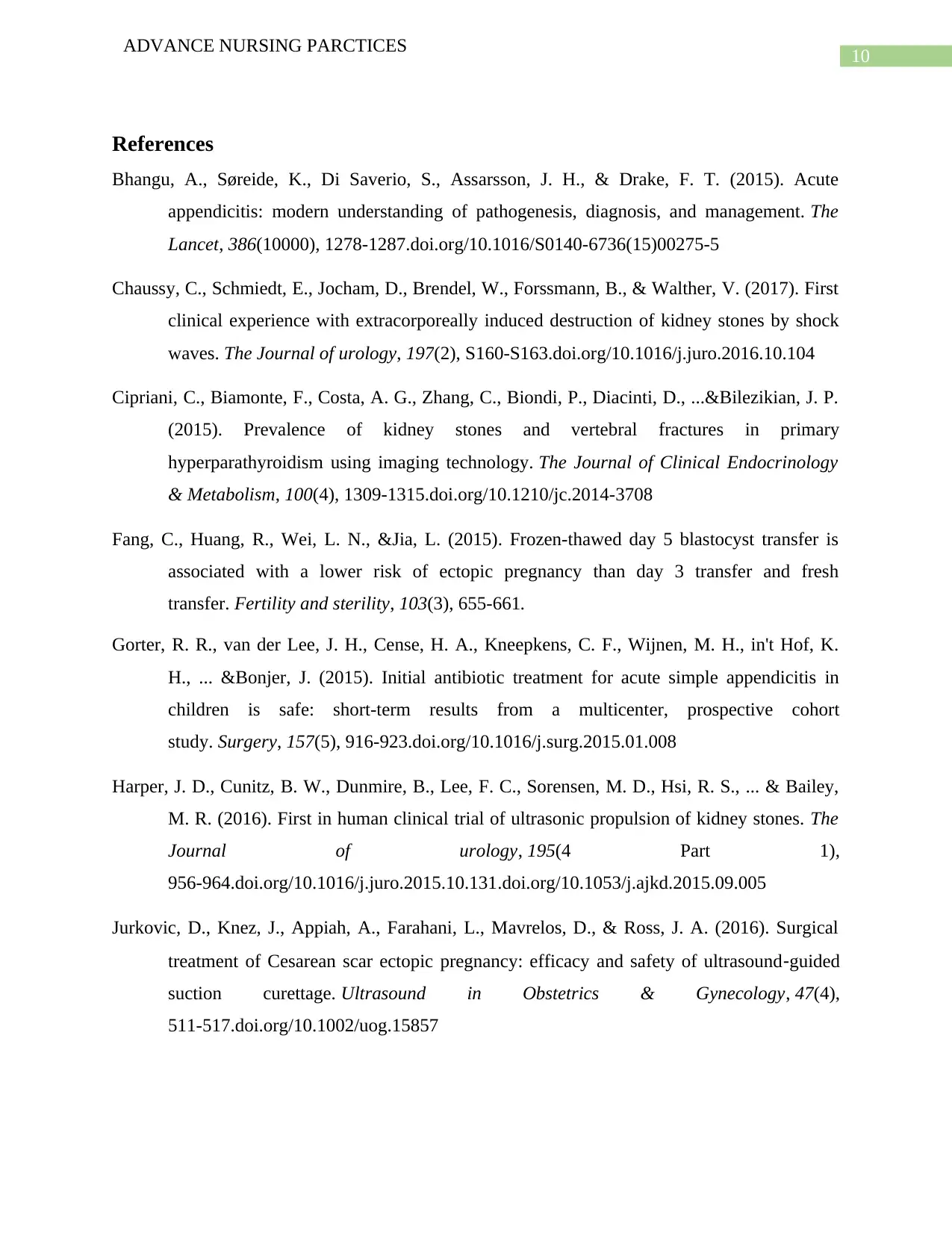
10
ADVANCE NURSING PARCTICES
References
Bhangu, A., Søreide, K., Di Saverio, S., Assarsson, J. H., & Drake, F. T. (2015). Acute
appendicitis: modern understanding of pathogenesis, diagnosis, and management. The
Lancet, 386(10000), 1278-1287.doi.org/10.1016/S0140-6736(15)00275-5
Chaussy, C., Schmiedt, E., Jocham, D., Brendel, W., Forssmann, B., & Walther, V. (2017). First
clinical experience with extracorporeally induced destruction of kidney stones by shock
waves. The Journal of urology, 197(2), S160-S163.doi.org/10.1016/j.juro.2016.10.104
Cipriani, C., Biamonte, F., Costa, A. G., Zhang, C., Biondi, P., Diacinti, D., ...&Bilezikian, J. P.
(2015). Prevalence of kidney stones and vertebral fractures in primary
hyperparathyroidism using imaging technology. The Journal of Clinical Endocrinology
& Metabolism, 100(4), 1309-1315.doi.org/10.1210/jc.2014-3708
Fang, C., Huang, R., Wei, L. N., &Jia, L. (2015). Frozen-thawed day 5 blastocyst transfer is
associated with a lower risk of ectopic pregnancy than day 3 transfer and fresh
transfer. Fertility and sterility, 103(3), 655-661.
Gorter, R. R., van der Lee, J. H., Cense, H. A., Kneepkens, C. F., Wijnen, M. H., in't Hof, K.
H., ... &Bonjer, J. (2015). Initial antibiotic treatment for acute simple appendicitis in
children is safe: short-term results from a multicenter, prospective cohort
study. Surgery, 157(5), 916-923.doi.org/10.1016/j.surg.2015.01.008
Harper, J. D., Cunitz, B. W., Dunmire, B., Lee, F. C., Sorensen, M. D., Hsi, R. S., ... & Bailey,
M. R. (2016). First in human clinical trial of ultrasonic propulsion of kidney stones. The
Journal of urology, 195(4 Part 1),
956-964.doi.org/10.1016/j.juro.2015.10.131.doi.org/10.1053/j.ajkd.2015.09.005
Jurkovic, D., Knez, J., Appiah, A., Farahani, L., Mavrelos, D., & Ross, J. A. (2016). Surgical
treatment of Cesarean scar ectopic pregnancy: efficacy and safety of ultrasound‐guided
suction curettage. Ultrasound in Obstetrics & Gynecology, 47(4),
511-517.doi.org/10.1002/uog.15857
ADVANCE NURSING PARCTICES
References
Bhangu, A., Søreide, K., Di Saverio, S., Assarsson, J. H., & Drake, F. T. (2015). Acute
appendicitis: modern understanding of pathogenesis, diagnosis, and management. The
Lancet, 386(10000), 1278-1287.doi.org/10.1016/S0140-6736(15)00275-5
Chaussy, C., Schmiedt, E., Jocham, D., Brendel, W., Forssmann, B., & Walther, V. (2017). First
clinical experience with extracorporeally induced destruction of kidney stones by shock
waves. The Journal of urology, 197(2), S160-S163.doi.org/10.1016/j.juro.2016.10.104
Cipriani, C., Biamonte, F., Costa, A. G., Zhang, C., Biondi, P., Diacinti, D., ...&Bilezikian, J. P.
(2015). Prevalence of kidney stones and vertebral fractures in primary
hyperparathyroidism using imaging technology. The Journal of Clinical Endocrinology
& Metabolism, 100(4), 1309-1315.doi.org/10.1210/jc.2014-3708
Fang, C., Huang, R., Wei, L. N., &Jia, L. (2015). Frozen-thawed day 5 blastocyst transfer is
associated with a lower risk of ectopic pregnancy than day 3 transfer and fresh
transfer. Fertility and sterility, 103(3), 655-661.
Gorter, R. R., van der Lee, J. H., Cense, H. A., Kneepkens, C. F., Wijnen, M. H., in't Hof, K.
H., ... &Bonjer, J. (2015). Initial antibiotic treatment for acute simple appendicitis in
children is safe: short-term results from a multicenter, prospective cohort
study. Surgery, 157(5), 916-923.doi.org/10.1016/j.surg.2015.01.008
Harper, J. D., Cunitz, B. W., Dunmire, B., Lee, F. C., Sorensen, M. D., Hsi, R. S., ... & Bailey,
M. R. (2016). First in human clinical trial of ultrasonic propulsion of kidney stones. The
Journal of urology, 195(4 Part 1),
956-964.doi.org/10.1016/j.juro.2015.10.131.doi.org/10.1053/j.ajkd.2015.09.005
Jurkovic, D., Knez, J., Appiah, A., Farahani, L., Mavrelos, D., & Ross, J. A. (2016). Surgical
treatment of Cesarean scar ectopic pregnancy: efficacy and safety of ultrasound‐guided
suction curettage. Ultrasound in Obstetrics & Gynecology, 47(4),
511-517.doi.org/10.1002/uog.15857
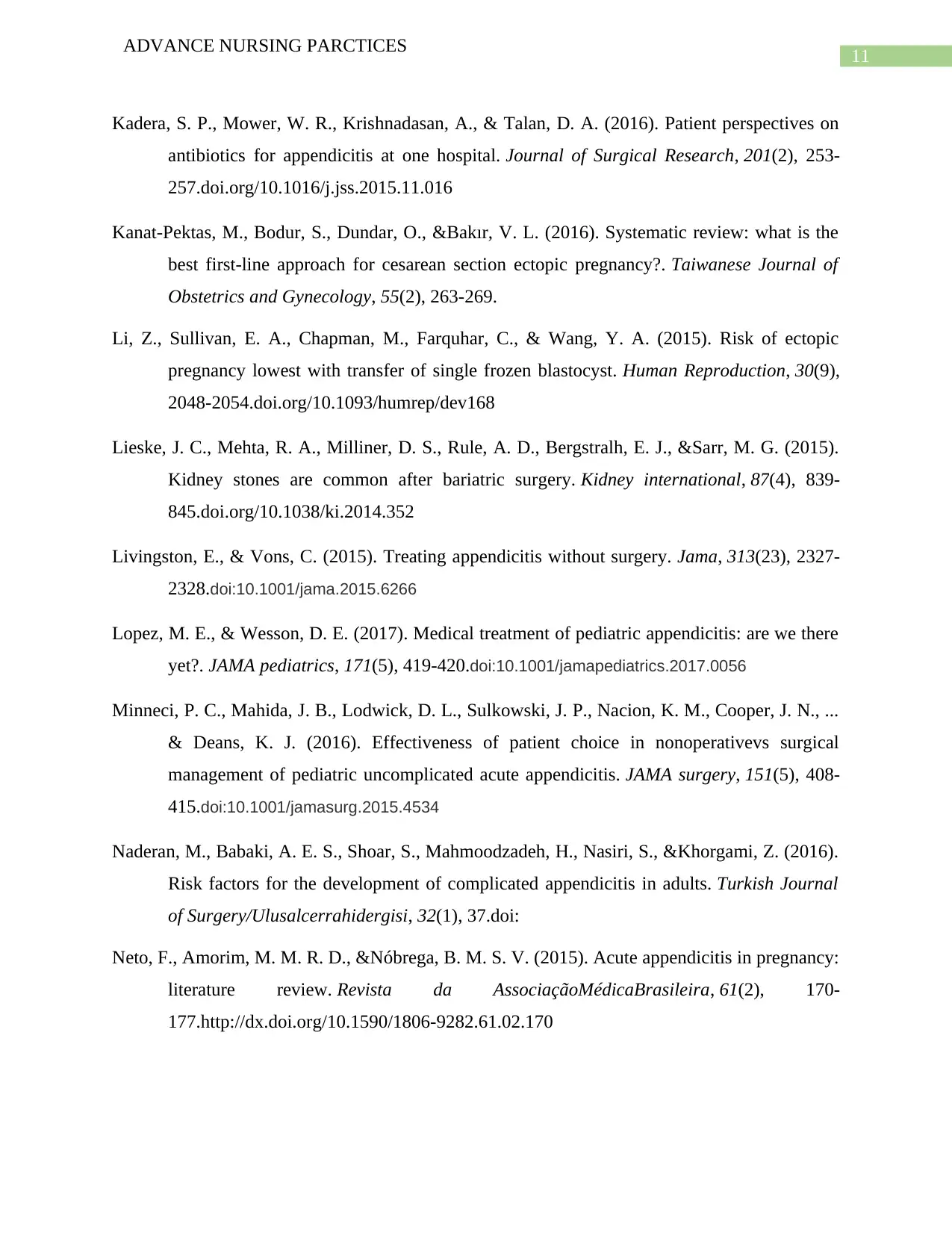
11
ADVANCE NURSING PARCTICES
Kadera, S. P., Mower, W. R., Krishnadasan, A., & Talan, D. A. (2016). Patient perspectives on
antibiotics for appendicitis at one hospital. Journal of Surgical Research, 201(2), 253-
257.doi.org/10.1016/j.jss.2015.11.016
Kanat-Pektas, M., Bodur, S., Dundar, O., &Bakır, V. L. (2016). Systematic review: what is the
best first-line approach for cesarean section ectopic pregnancy?. Taiwanese Journal of
Obstetrics and Gynecology, 55(2), 263-269.
Li, Z., Sullivan, E. A., Chapman, M., Farquhar, C., & Wang, Y. A. (2015). Risk of ectopic
pregnancy lowest with transfer of single frozen blastocyst. Human Reproduction, 30(9),
2048-2054.doi.org/10.1093/humrep/dev168
Lieske, J. C., Mehta, R. A., Milliner, D. S., Rule, A. D., Bergstralh, E. J., &Sarr, M. G. (2015).
Kidney stones are common after bariatric surgery. Kidney international, 87(4), 839-
845.doi.org/10.1038/ki.2014.352
Livingston, E., & Vons, C. (2015). Treating appendicitis without surgery. Jama, 313(23), 2327-
2328.doi:10.1001/jama.2015.6266
Lopez, M. E., & Wesson, D. E. (2017). Medical treatment of pediatric appendicitis: are we there
yet?. JAMA pediatrics, 171(5), 419-420.doi:10.1001/jamapediatrics.2017.0056
Minneci, P. C., Mahida, J. B., Lodwick, D. L., Sulkowski, J. P., Nacion, K. M., Cooper, J. N., ...
& Deans, K. J. (2016). Effectiveness of patient choice in nonoperativevs surgical
management of pediatric uncomplicated acute appendicitis. JAMA surgery, 151(5), 408-
415.doi:10.1001/jamasurg.2015.4534
Naderan, M., Babaki, A. E. S., Shoar, S., Mahmoodzadeh, H., Nasiri, S., &Khorgami, Z. (2016).
Risk factors for the development of complicated appendicitis in adults. Turkish Journal
of Surgery/Ulusalcerrahidergisi, 32(1), 37.doi:
Neto, F., Amorim, M. M. R. D., &Nóbrega, B. M. S. V. (2015). Acute appendicitis in pregnancy:
literature review. Revista da AssociaçãoMédicaBrasileira, 61(2), 170-
177.http://dx.doi.org/10.1590/1806-9282.61.02.170
ADVANCE NURSING PARCTICES
Kadera, S. P., Mower, W. R., Krishnadasan, A., & Talan, D. A. (2016). Patient perspectives on
antibiotics for appendicitis at one hospital. Journal of Surgical Research, 201(2), 253-
257.doi.org/10.1016/j.jss.2015.11.016
Kanat-Pektas, M., Bodur, S., Dundar, O., &Bakır, V. L. (2016). Systematic review: what is the
best first-line approach for cesarean section ectopic pregnancy?. Taiwanese Journal of
Obstetrics and Gynecology, 55(2), 263-269.
Li, Z., Sullivan, E. A., Chapman, M., Farquhar, C., & Wang, Y. A. (2015). Risk of ectopic
pregnancy lowest with transfer of single frozen blastocyst. Human Reproduction, 30(9),
2048-2054.doi.org/10.1093/humrep/dev168
Lieske, J. C., Mehta, R. A., Milliner, D. S., Rule, A. D., Bergstralh, E. J., &Sarr, M. G. (2015).
Kidney stones are common after bariatric surgery. Kidney international, 87(4), 839-
845.doi.org/10.1038/ki.2014.352
Livingston, E., & Vons, C. (2015). Treating appendicitis without surgery. Jama, 313(23), 2327-
2328.doi:10.1001/jama.2015.6266
Lopez, M. E., & Wesson, D. E. (2017). Medical treatment of pediatric appendicitis: are we there
yet?. JAMA pediatrics, 171(5), 419-420.doi:10.1001/jamapediatrics.2017.0056
Minneci, P. C., Mahida, J. B., Lodwick, D. L., Sulkowski, J. P., Nacion, K. M., Cooper, J. N., ...
& Deans, K. J. (2016). Effectiveness of patient choice in nonoperativevs surgical
management of pediatric uncomplicated acute appendicitis. JAMA surgery, 151(5), 408-
415.doi:10.1001/jamasurg.2015.4534
Naderan, M., Babaki, A. E. S., Shoar, S., Mahmoodzadeh, H., Nasiri, S., &Khorgami, Z. (2016).
Risk factors for the development of complicated appendicitis in adults. Turkish Journal
of Surgery/Ulusalcerrahidergisi, 32(1), 37.doi:
Neto, F., Amorim, M. M. R. D., &Nóbrega, B. M. S. V. (2015). Acute appendicitis in pregnancy:
literature review. Revista da AssociaçãoMédicaBrasileira, 61(2), 170-
177.http://dx.doi.org/10.1590/1806-9282.61.02.170
⊘ This is a preview!⊘
Do you want full access?
Subscribe today to unlock all pages.

Trusted by 1+ million students worldwide
1 out of 13
Related Documents
Your All-in-One AI-Powered Toolkit for Academic Success.
+13062052269
info@desklib.com
Available 24*7 on WhatsApp / Email
![[object Object]](/_next/static/media/star-bottom.7253800d.svg)
Unlock your academic potential
Copyright © 2020–2025 A2Z Services. All Rights Reserved. Developed and managed by ZUCOL.





